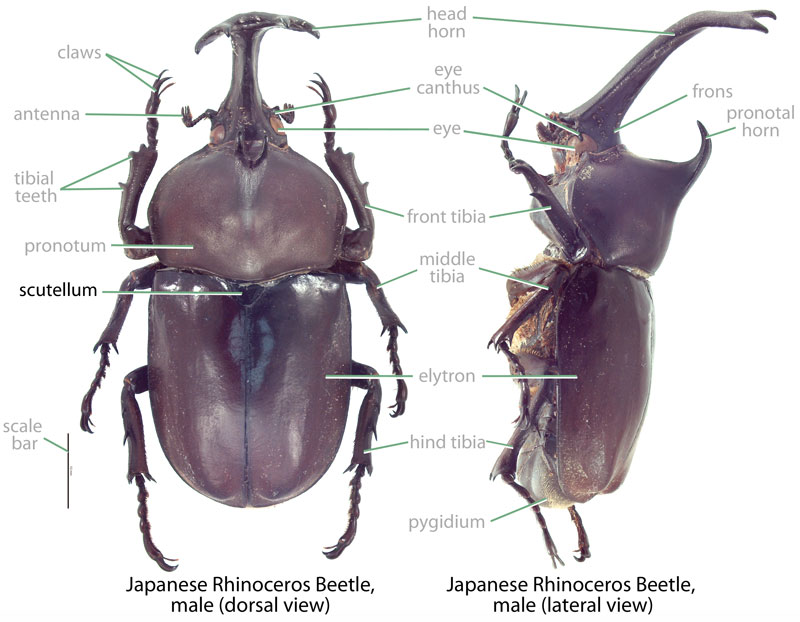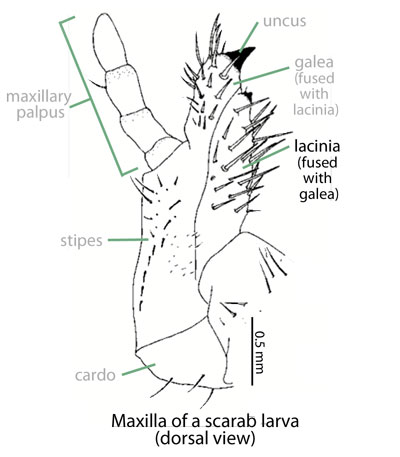Beneficial
granulose dung beetle
Family: Scarabaeidae Subfamily: Scarabaeinae Genus: Onthophagus Species: Onthophagus granulatus Boheman, 1858
none available
Total body length 6.0–8.0 mm (0.23–0.31 in). Body shape oval; may be caked in dung. Color dull brownish. Small-sized Onthophagus, 6-10 mm. Clypealclypeal:
of, or referring to, the clypeus
apexapex:
point or edge furthest from the body
of major male produced, strongly recurvedrecurved:
bending backwards
; not produced and recurvedrecurved:
bending backwards
in minor male or female. Head of male lacking horns; minor male and female with transversetransverse:
extending horizontally across a surface
ridge near base. Ocular canthuscanthus:
a process extending over and sometimes dividing the eye
not completely dividing eye. Pronotumpronotum:
the dorsal surface of the thorax
 with anterioranterior:
with anterioranterior:
the front or forward; opposite of posterior
angle rounded or weakly acute. Pronotumpronotum:
the dorsal surface of the thorax
 of major male with single lobe-like process; minor male and female with 4 weak, tubercle-like processes. Front tibiatibia:
of major male with single lobe-like process; minor male and female with 4 weak, tubercle-like processes. Front tibiatibia:
a segment of the leg articulated with the tarsus and femur
 of male slender, female tibiatibia:
of male slender, female tibiatibia:
a segment of the leg articulated with the tarsus and femur
 comparatively more robust. Scutellumscutellum:
comparatively more robust. Scutellumscutellum:
the triangular portion of the thorax between the bases of the elytra
 absent.
absent.
Undescribed. For Onthophagus spp. (Ritcher, 1966Ritcher, 1966:
Ritcher P. 1966. White grubs and their allies: a study of North American scarabaeoid larvae. Oregon State University Monographs, Studies in Entomology 4: 1-219.): Grub C-shaped, hump-backed, cylindrical, and cream-colored. Maxillamaxilla:
set of paired mouthparts located posterior to the mandibles
with galeagalea:
outer branch or lobe of the maxilla
 and lacinialacinia:
and lacinialacinia:
inner portion of the maxilla distinctly separate. Epipharynxepipharynx:
distinctly separate. Epipharynxepipharynx:
lobe on the interior surface of the labrum or clypeus
with tormaetormae:
in scarab larvae, sclerotized structures on the ends of the clypeolateral suture extending towards the mesal line
united mesallymesally:
at or near midline of body
, anterioranterior:
the front or forward; opposite of posterior
phoba present. AntennaeAntennae:
paired sensory organ on head, formed from numerous segments
 4-segmented, distaldistal:
4-segmented, distaldistal:
situated away from the point of articulation, thus usually furthest from the body
segment much reduced. Legs 2-segmented. Prothoracic shieldprothoracic shield:
the chitinous plate behind the head of larvae
 without anteriorly projecting processes. Third abdominal segment bearing a prominent conical, dorsaldorsal:
without anteriorly projecting processes. Third abdominal segment bearing a prominent conical, dorsaldorsal:
of or relating to the upper surface; opposite of ventral
gibbosity covered with numerous short, stout setaesetae:
small, hair-like structure
.
Australia. This species is native to eastern Australia. It has been recorded occurring from the province of Victoria northward to Mackay in Queensland (Matthews, 1972Matthews, 1972:
Matthews E. 1972. A revision of the Scarabaeine dung beetles of Australia. I. Tribe Onthophagini. Australian Journal of Zoology Supplementary Series 19: 3-330.). It is also known from New Zealand, where it established in the 1870's (Forgie, 2009Forgie, 2009:
Forgie S. 2009. Reproductive activity of Onthophagus granulatus Boheman (Coleoptera: Scarabaeinae) in New Zealand: implications for its effectiveness in the control of pastoral dung. New Zealand Entomologist 32: 76-84. DOI: 10.1080/00779962.2009.9722179).
None. This species feeds on dung as both an adult and larvalarva:
the immature form of an insect; in scarabs, also called grub or white grub; preceded by the egg stage, followed by the pupal stage
 . There are no records of this beetle feeding on live plant tissues.
. There are no records of this beetle feeding on live plant tissues.
This diurnaldiurnal:
active during daylight hours
scarab is known from pastures and other open areas, particularly where soils are sandy (Matthews, 1972Matthews, 1972:
Matthews E. 1972. A revision of the Scarabaeine dung beetles of Australia. I. Tribe Onthophagini. Australian Journal of Zoology Supplementary Series 19: 3-330.). Adults live up to 46 weeks (Forgie, 2009Forgie, 2009:
Forgie S. 2009. Reproductive activity of Onthophagus granulatus Boheman (Coleoptera: Scarabaeinae) in New Zealand: implications for its effectiveness in the control of pastoral dung. New Zealand Entomologist 32: 76-84. DOI: 10.1080/00779962.2009.9722179) and have been recorded from carrion as well as dung (human, cattle, sheep, and wallaby) (Matthews, 1972Matthews, 1972:
Matthews E. 1972. A revision of the Scarabaeine dung beetles of Australia. I. Tribe Onthophagini. Australian Journal of Zoology Supplementary Series 19: 3-330.). After locating suitable feces, females create a burrow under or near the dung source (Forgie, 2009Forgie, 2009:
Forgie S. 2009. Reproductive activity of Onthophagus granulatus Boheman (Coleoptera: Scarabaeinae) in New Zealand: implications for its effectiveness in the control of pastoral dung. New Zealand Entomologist 32: 76-84. DOI: 10.1080/00779962.2009.9722179). The burrow is then provisioned with dung in the form of brood balls. Each ball is impregnated with an egg; larval development occurs within the brood ball. There is a single generation per year (Forgie, 2009Forgie, 2009:
Forgie S. 2009. Reproductive activity of Onthophagus granulatus Boheman (Coleoptera: Scarabaeinae) in New Zealand: implications for its effectiveness in the control of pastoral dung. New Zealand Entomologist 32: 76-84. DOI: 10.1080/00779962.2009.9722179). Duration from egg to adult is 6–10 weeks, with adult numbers peaking in early summer (Forgie, 2009Forgie, 2009:
Forgie S. 2009. Reproductive activity of Onthophagus granulatus Boheman (Coleoptera: Scarabaeinae) in New Zealand: implications for its effectiveness in the control of pastoral dung. New Zealand Entomologist 32: 76-84. DOI: 10.1080/00779962.2009.9722179).
None. This species recycles dung and is beneficial for ranching and farming in Hawaii. Primarily being a dung feeder, this species has never been recorded damaging crop or ornamental plants. Additionally, this scarab is not a threat to native dung beetles because none occur in Hawaii or Guam. An odd record of this species killing a horse through perforation of the horse's stomach (Matthews, 1972Matthews, 1972:
Matthews E. 1972. A revision of the Scarabaeine dung beetles of Australia. I. Tribe Onthophagini. Australian Journal of Zoology Supplementary Series 19: 3-330.) should be regarded with skepticism.
Recorded, not established. This species was intentionally brought to Hawaii in 1921, though it is unclear if any individuals were released (Hawaii Division of Forestry, 1923Hawaii Division of Forestry, 1923:
Anonymous. 1923. Report of the entomologist. Hawaii Board of Commissioners of Agriculture and Forestry. Division of Forestry. Honolulu, HI: Hawaiian Gazette Company.). Similar dung beetle introductions were undertaken to help control populations of the horn fly (Haematobia irritans), a biting pest of livestock (Markin and Yoshioka, 1998Markin and Yoshioka, 1998:
Markin G and Yoshioka E. 1998. Biological control of the horn fly, Haematobia irritans L., in Hawai'i (Diptera: Muscidae). Proceedings of the Hawaiian Entomological Society 33: 43-50. full text (accessed 2015)). If this species was released, it failed to establish populations in the state (Nishida, 2002Nishida, 2002:
Nishida G (editor). 2002. Hawaiian terrestrial arthropod checklist, fourth edition. Bishop Museum Technical Report 22: 1-313.).
Not established or recorded. There are no records of this species from Guam.
In Hawaii, this species was intentionally imported.
This scarab could be confused with Onthophagus of similar color and small-size (6–10 mm): Onthophagus foliaceus and Onthophagus nuchicornis.
Major males of these species can quickly be distinguished by examination of the head (O. granulatus lacking horns, instead with strongly recurvedrecurved:
bending backwards
, produced clypealclypeal:
of, or referring to, the clypeus
apexapex:
point or edge furthest from the body
versus O. nuchicornis with single spine-like horn, O. foliaceus with a single, long forward curving horn).
Minor males and females are somewhat more difficult to distinguish but can be separated by examination of the pronotumpronotum:
the dorsal surface of the thorax
 (O. granulatus with four tubercle-like processes versus O. nuchicornis with a rounded peg-like process, O. foliaceus without a process).
(O. granulatus with four tubercle-like processes versus O. nuchicornis with a rounded peg-like process, O. foliaceus without a process).
None known
Report your observation of this beneficial species at our iNaturalist project.